|

The Polish 'Vistula Legion'.
"...the [infantry of] Vistula Legion seemed particularly
destined to participate in sieges..." Napoleon stated that
the infantry [of Vistula Legion] were to be treated on a par
with French line regiments. - George Nafziger

 Left: voltigeur of 4th Vistula Legion.
Left: voltigeur of 4th Vistula Legion.
Picture by Herbert Knotel, Germany.
Right: private of Vistula Legion in Spain.
Picture by Keith Rocco, USA.
The most numerous and particularly dedicated to Napoleon were the Poles. Among the best Polish regiments were the four regiments of Vistula Legion. They served in every major campaign - in Italy, Spain, Germany, France and in Russia. In 1812 the four regiments were attached to Napoleon's Guard but during the retreat from Russia they fought often and very hard. In 1813 their debris were consolidated into one regiment. This gallant unit fought ferociously at Leipzig (1813) and at Arcis-sur-Aube (1814). When the wars ended there were only few men left in the ranks.
"In 1806, what was left of the old Dabowski and Kniaziewicz's Danube Legion ... was one infantry regiment and one cavalry regiment in the service of Kingdom of Naples.
In February 1807 these remnants became part of the French army and were sent to Silesia. These Polish veterans became the core of a new Polish Legion ... and were initially called the Polish-Italian Legion (Italian since they had fought in Italy, not because the unit had Italians in it).
Napoleon's decree of 1807 stated this Legion should consist of three infantry regiments and one cavalry regiment. ... In June, the formation took part in the siege of Klodzko. From Silesia the Legion moved to service in Westphalia in October 1807 ... On 21 February 1808, Napoleon ordered the Legion to Poitiers in France, where it was formally inducted into the French army. In a letter to Davout dated 31 March 1808, Napoleon renamed the Polish-Italian Legion (Polacco-Italienne) the "Vistula Legion."
He also stated that the infantry were to be treated on a par with French line regiments ... The depot for the Legion appears to have been Sedan. ...
It should also be noted that French nationals were not permitted to serve in the Legion, except as the company clerks (fourriers), battalion adjutant non-commissioned officers, and as paymasters. The Poles, apparently, had little concern for administrative duties and, driven to desperation, Napoleon relented on these administrative positions. ...
After the battle of Wagram (1809), Napoleon found that he was once again in possession of a large number of ethnic Poles amongst his Austrian prisoners of war. The Decree of 8 July, 1809, directed that these men were to form a 2nd Vistula Legion. ... The 2nd Vistula Legion never was able to form completely, so it was disbanded by the Decrees of 12/15 February, 1810. It was incorporated into the 1st Vistula Legion as a 4th Regiment.
The Vistula Legion was sent to Spain where it fought in the sieges of Saragossa and Segunto. In fact, the Vistula Legion seemed particularly destined to participate in sieges, and it fought in all of the major sieges in eastern Spain during the early years of the Peninsular War. ...
In preparation for the invasion of Russia the Vistula Legion was withdrawn from Spain in early 1812. ... On 2 April, 1812, Napoleon decided to include the Poles in the Young Guard corps under Marshal Mortier rather than designating them as Guard. The third battalions were formed, but on 31 May, after reviewing them in Posen, Napoleon directed that they not form elite companies, feeling their soldiers were too young. However, they would follow the main army as far as Smolensk and Gjatsk, joining the main body only during the retreat in the beginning of November. ... The 4th Regiment was still in Spain while the other regiments went to Russia. ... These men had fought bravely at Smolensk, Borodino, Tarutino, Krasnoe and at the Berezina Crossing. " (- George Nafziger)
AUGUST 1812.
Infantry Division of Vistula Legion
Commander: General de Division Michel Claparede (ext.link)
Second in Command: General de Brigade Chlopicki
Chief-of-Staff: Colonel Briatte
- - - - - - 1st Brigade - General de Brigade Chlopicki
- - - - - - - - - - - - 1st Regiment of Vistula Legion
- - - - - - - - - - - - 2nd Regiment of Vistula Legion
- - - - - - 2nd Brigade - General de Brigade Bronikowski
- - - - - - - - - - - - 3rd Regiment of Vistula Legion
- - - - - - - - - - - - 4th Regiment of Vistula Legion
- - - - - - Artillery.
- - - - - - - - - - - - Foot Battery (4 cannons and 2 howitzers)
- - - - - - - - - - - - Foot Battery (4 cannons and 2 howitzers)
"On 18 June, 1813, a Vistula Regiment was organized from the remnants of the Vistula Legion. It consisted of only two battalions. ... On 15 September the Legion fought the Russians in a bloody engagement at Neustadt (near Dresden). The Legion, which participated in several small engagements and skirmishes, was virtually destroyed at the Battles of Leipzig on 15-19 October, and at Hanau, where they helped sweep aside the Bavarian army blocking the retreat route to France.
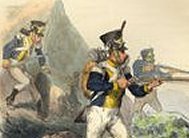 The Legion was reformed at Sedan in early 1814. All the Poles remaining in French service were utilized in an effort to bring it up to strength. At Soissons, on 2 March, 1814, it fought valiantly against the blockading Russian forces. After earning 23 Legions d 'honneur (two officers and 21 soldiers) at Soissons, the Legion moved to the Compiegne. They fought at Rheims (2 March) and Arcis-sur-Aube (20 March) where Napoleon sought shelter in one of its battalions as it formed square. The Legion then went on to fight at the battle at St. Dizier. When the war ended, the survivors returned to Poland.
During the 1815 campaign,325 men under a Colonel Golaszewski appear to have been the last of the Vistula Legion to serve under Napoleon." (Nafziger - "Poles and Saxons")
The Legion was reformed at Sedan in early 1814. All the Poles remaining in French service were utilized in an effort to bring it up to strength. At Soissons, on 2 March, 1814, it fought valiantly against the blockading Russian forces. After earning 23 Legions d 'honneur (two officers and 21 soldiers) at Soissons, the Legion moved to the Compiegne. They fought at Rheims (2 March) and Arcis-sur-Aube (20 March) where Napoleon sought shelter in one of its battalions as it formed square. The Legion then went on to fight at the battle at St. Dizier. When the war ended, the survivors returned to Poland.
During the 1815 campaign,325 men under a Colonel Golaszewski appear to have been the last of the Vistula Legion to serve under Napoleon." (Nafziger - "Poles and Saxons")
 - 1er Regiment d’Infanterie de la Legion de la Vistule - 1er Regiment d’Infanterie de la Legion de la Vistule
28 Battles: 1806 - St.Euphemie, Mangona, and Codron, 1807 - Salzbrunn, 1808 - Mallen, Allagon, Saragosse, Tudela, and Tavenca, 1809 - Saragosse, Alcanitz, Maria, Belchite, and Stella, 1810 - Villet-Checa, 1811 - Tarragona, Murviedra, Gratalope and Fairet, 1812 - Valence, Smolensk, Chirikovo, Borodino, Krimskoie, Voronowo, Beresina, Krasnoie, and Wilna
Colonels: 1808 - Chlopicki, 1809 - Kosinowski, 1811 - Fondzielski, 1812 - Kosinowski
 - 2e Regiment d’Infanterie de la Legion de la Vistule - 2e Regiment d’Infanterie de la Legion de la Vistule
28 Battles: 1808 - Saragosse and Tudela, 1809 - Perdiguera, Santa Fe, Belchite, Aquila, El Fresna, Calatayud, Retascon, Daroca, Ojos Negros and Tremedal, 1810 - Torre la Carcel, Teruel, Villastar, Villel, Lancosa, Tortosa and Fuente Santa, 1811 - Azuara, 1812 - Valence, Smolensk, Woronowo, Beresina, Tarutino, Wilna and Kowno, 1813 - Wittenberg
Colonels: 1808 - Bialowieyski, 1808 - Kosinowski, 1809 - Michalowski ?, 1812 - Chlusowicz, 1812 - Malczewski
 - 3e Regiment d’Infanterie de la Legion de la Vistule - 3e Regiment d’Infanterie de la Legion de la Vistule
10 Battles: 1808 - Saragosse, 1809 - Saragosse, 1812 - Smolensk, Chirikovo, Borodino, Krimskoie, Voronowo, Beresina, Krasnoie, and Wilna
Colonels: 1807 - Swiderski, 1809 - Estko, 1812 - Kosinski, 1812 - Szott (Fondzielski ?)
 - 4e Regiment d’Infanterie de la Legion de la Vistule - 4e Regiment d’Infanterie de la Legion de la Vistule
13 Battles: 1810 - Puebla de Senabria, Benevente, Santa Martha, 1811 - Puebla, Aldea-del-Ponte, Tabara, Salinas and Penaranda, 1812 - Tudela, Ontario and Penaranda,
1813 - Rogozno and Parkowo
Colonels:1812 - Bronikowski and Estko
|
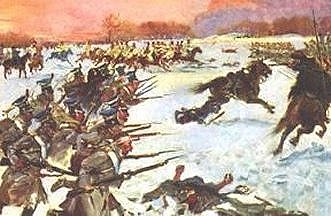



 Napoleon's foreign troops comprised three categories:
Napoleon's foreign troops comprised three categories: The foreigners also served in Napoleon's Imperial Guard. The Dutch formed 3rd Regiment of Foot Grenadiers and 2nd Regiment of Lancers (the famous Red Lancers). The Italians formed Velites of Turin and Velites of Florence.
The foreigners also served in Napoleon's Imperial Guard. The Dutch formed 3rd Regiment of Foot Grenadiers and 2nd Regiment of Lancers (the famous Red Lancers). The Italians formed Velites of Turin and Velites of Florence.
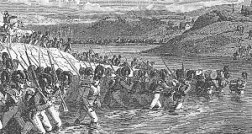 -------------------------------------------------------------------------------------
-------------------------------------------------------------------------------------  Picture: Tirailleurs Corses and Tirailleurs du Po in Ebersberg.
Tirée d'l'épopée Napoléonienne du Dr Hourtoulle & Jack Girbal.
Picture: Tirailleurs Corses and Tirailleurs du Po in Ebersberg.
Tirée d'l'épopée Napoléonienne du Dr Hourtoulle & Jack Girbal.
 One of the very best light outfits serving in Napoleon's army was the battalion called Tirailleurs Corses. It was raised in 1803 and Philippe d'Ornano, a Napoleon's cousin (he married Marie Waleska in 1822), was chef de bataillon and they were for this reason nicknamed "les cousins de l'Empereur". It was not an italian battalion like the "Tirailleurs du Po".
All the soldiers of Tirailleurs Corses were volunteers and all Corsicans, except one officer (the quartermaster). Its depot company was located in Corsica.
One of the very best light outfits serving in Napoleon's army was the battalion called Tirailleurs Corses. It was raised in 1803 and Philippe d'Ornano, a Napoleon's cousin (he married Marie Waleska in 1822), was chef de bataillon and they were for this reason nicknamed "les cousins de l'Empereur". It was not an italian battalion like the "Tirailleurs du Po".
All the soldiers of Tirailleurs Corses were volunteers and all Corsicans, except one officer (the quartermaster). Its depot company was located in Corsica.
 PS.
PS. "The Swiss, like all mountaineers, make capital soldiers when drilled; and, wherever they have served as regular troops under foreign banners, they have fought exceedingly well.
But being rather slow-headed, they need drilling much more, indeed, than either French or North Germans, to give them confidence in themselves and cohesion."
(Source -"The Armies of Europe" in Putnam's Monthly, No. XXXII, published in 1855 )
"The Swiss, like all mountaineers, make capital soldiers when drilled; and, wherever they have served as regular troops under foreign banners, they have fought exceedingly well.
But being rather slow-headed, they need drilling much more, indeed, than either French or North Germans, to give them confidence in themselves and cohesion."
(Source -"The Armies of Europe" in Putnam's Monthly, No. XXXII, published in 1855 )


 Left: voltigeur of 4th Vistula Legion.
Left: voltigeur of 4th Vistula Legion. The Legion was reformed at Sedan in early 1814. All the Poles remaining in French service were utilized in an effort to bring it up to strength. At Soissons, on 2 March, 1814, it fought valiantly against the blockading Russian forces. After earning 23 Legions d 'honneur (two officers and 21 soldiers) at Soissons, the Legion moved to the Compiegne. They fought at Rheims (2 March) and Arcis-sur-Aube (20 March) where Napoleon sought shelter in one of its battalions as it formed square. The Legion then went on to fight at the battle at St. Dizier. When the war ended, the survivors returned to Poland.
During the 1815 campaign,325 men under a Colonel Golaszewski appear to have been the last of the Vistula Legion to serve under Napoleon." (Nafziger - "Poles and Saxons")
The Legion was reformed at Sedan in early 1814. All the Poles remaining in French service were utilized in an effort to bring it up to strength. At Soissons, on 2 March, 1814, it fought valiantly against the blockading Russian forces. After earning 23 Legions d 'honneur (two officers and 21 soldiers) at Soissons, the Legion moved to the Compiegne. They fought at Rheims (2 March) and Arcis-sur-Aube (20 March) where Napoleon sought shelter in one of its battalions as it formed square. The Legion then went on to fight at the battle at St. Dizier. When the war ended, the survivors returned to Poland.
During the 1815 campaign,325 men under a Colonel Golaszewski appear to have been the last of the Vistula Legion to serve under Napoleon." (Nafziger - "Poles and Saxons")
 Picture (from left to right):
Drummer of 1st Croatian Provisional Regiment in 1812 in Russia
and Voltigeur of 3rd Croatian Provisional Regiment in Russia.
(Please let us know who is the author of this picture.)
Picture (from left to right):
Drummer of 1st Croatian Provisional Regiment in 1812 in Russia
and Voltigeur of 3rd Croatian Provisional Regiment in Russia.
(Please let us know who is the author of this picture.)
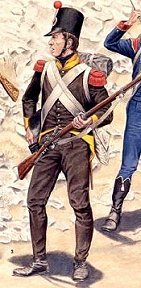
 "To collect discharged Piedmontese veterans, who probably were ocassionally drunk and disorderly
Napoleon ordered the formation of a 1st Piedmontese Legion. ... Napoleon sent its 1st and 2nd battalion and the artillery company to West Indies, where most of them died of diseas.
The few men remaining there were adopted by the 82nd Line. The 3rd battalion, which had been unable to sail because of British blockade, was redesignated the 1st, and a new 2nd battalion was enlisted a prix de argent and very slowly. Those two battalions became the 2nd Legion du Midi. After a stint of coast defense duty it went into Spain, where it served well enough but gradually fell off in strength to a single battalion." (- John Elting)
"To collect discharged Piedmontese veterans, who probably were ocassionally drunk and disorderly
Napoleon ordered the formation of a 1st Piedmontese Legion. ... Napoleon sent its 1st and 2nd battalion and the artillery company to West Indies, where most of them died of diseas.
The few men remaining there were adopted by the 82nd Line. The 3rd battalion, which had been unable to sail because of British blockade, was redesignated the 1st, and a new 2nd battalion was enlisted a prix de argent and very slowly. Those two battalions became the 2nd Legion du Midi. After a stint of coast defense duty it went into Spain, where it served well enough but gradually fell off in strength to a single battalion." (- John Elting)

 There were also so-called regiments etrangers - for some reason considered light infantry
though seldom if ever specifically so employed.
They were given very showy uniforms to attract recruits. One Frenchman wrote about the 1st
Foreign Regiment: "in their handsome green uniforms, they made a large number of female conquests, especially among cooks."
(Elting - "Napoleonic Uniforms" Vol 2)
There were also so-called regiments etrangers - for some reason considered light infantry
though seldom if ever specifically so employed.
They were given very showy uniforms to attract recruits. One Frenchman wrote about the 1st
Foreign Regiment: "in their handsome green uniforms, they made a large number of female conquests, especially among cooks."
(Elting - "Napoleonic Uniforms" Vol 2)
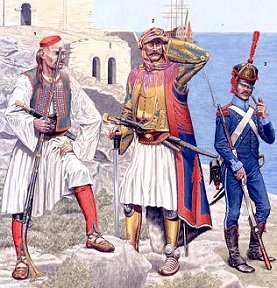 Picture (from left to righ):
Private and officer of Albanian Regiment in 1808-1813.
Chasseur of Septinsular Battalion in 1808-1812.
(Please let us know who is the author of this beautiful picture.)
Picture (from left to righ):
Private and officer of Albanian Regiment in 1808-1813.
Chasseur of Septinsular Battalion in 1808-1812.
(Please let us know who is the author of this beautiful picture.)
